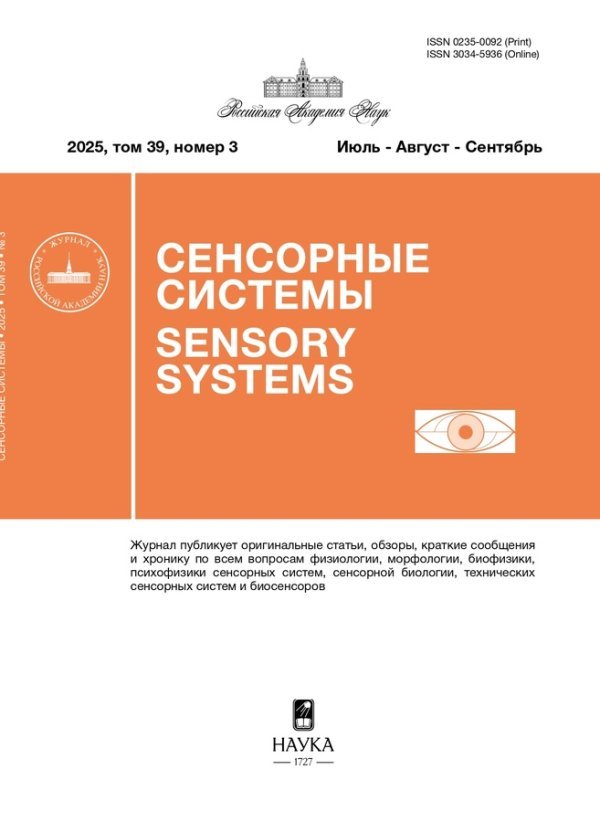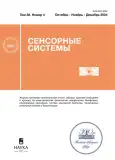Состояние пространственного слуха при симметричной сенсоневральной тугоухости 1-й и 2-й степени по данным опросника SHQ
- Авторы: Клишова Е.А.1, Голованова Л.Е.1, Андреева И.Г.1
-
Учреждения:
- Институт эволюционной физиологии и биохимии им. И.М. Сеченова РАН
- Выпуск: Том 38, № 4 (2024)
- Страницы: 49-59
- Раздел: СЛУХОВАЯ СИСТЕМА
- URL: https://gynecology.orscience.ru/0235-0092/article/view/675771
- DOI: https://doi.org/10.31857/S0235009224040059
- EDN: https://elibrary.ru/ADBTWO
- ID: 675771
Цитировать
Полный текст
Аннотация
Исследовано состояние пространственного слуха у пациентов с симметричной хронической сенсоневральной тугоухостью (СНТ) 1-й и 2-й степени с применением русскоязычной версии опросника пространственного слуха. Обследован 141 пациент в возрасте от 47 до 82 лет. Сравнительный анализ выполняли в группах возрастной нормы слуха, СНТ 1-й и 2-й степени. Показано достоверное ухудшение пространственного восприятия, выявленное по результатам опроса в обеих группах с СНТ, причем по ряду показателей группы 1-й и 2-й степени достоверно различались. Ухудшение пространственного восприятия, выявленное при анализе подшкал опросника, и количественные оценки пространственного и временного разрешения, полученные ранее при СНТ 1-й и 2-й степени, находились в хорошем соответствии. При СНТ 2-й степени достоверно были снижены оценки всех четырех подшкал опросника. В клинической практике этот опросник можно применять в качестве скринингового метода оценки пространственного слуха у пациентов с СНТ.
Полный текст
Об авторах
Е. А. Клишова
Институт эволюционной физиологии и биохимии им. И.М. Сеченова РАН
Email: ig-andreeva@mail.ru
Россия, 194223, Санкт-Петербург, пр. Тореза, д. 44
Л. Е. Голованова
Институт эволюционной физиологии и биохимии им. И.М. Сеченова РАН
Email: ig-andreeva@mail.ru
Россия, 194223, Санкт-Петербург, пр. Тореза, д. 44
И. Г. Андреева
Институт эволюционной физиологии и биохимии им. И.М. Сеченова РАН
Автор, ответственный за переписку.
Email: ig-andreeva@mail.ru
Россия, 194223, Санкт-Петербург, пр. Тореза, д. 44
Список литературы
- Альтман Я. А., Таварткиладзе Г. А. Руководство по аудиологии. М.: ДМК Пресс, 2003. 360 с.
- Бабияк В. И., Накатис Я. А. Клиническая оториноларингология: Руководство для врачей. СПб.: Гиппократ. 2005. 800 с.
- Владимирова Т. Ю., Мартынова А. Б., Барбашева С. С. Валидация и перспективы применения русскоязычной версии опросника пространственного слуха (SHQ). Аспирантский вестник Поволжья. 2023. Т. 23. № 1. С. 15–20. doi: 10.55531/2072–2354.2023.23.1.15–20
- Королева И. В. Введение в аудиологию и слухопротезирование. СПб.: КАРО. 2012. 343 с.
- Aggius-Vella E., Gori M., Campus C. et al. Auditory distance perception in front and rear space. Hearing Research. 2022. V. 417. Article 108468. doi: 10.1016/j.heares.2022
- Akeroyd M. A. An overview of the major phenomena of the localization of sound sources by normal-hearing, hearing-impaired, and aided listeners. Trends in Hearing. 2014. V. 18. Article 2331216514560442. doi: 10.1177/2331216514560442
- Akeroyd M. A., Whitmer W. M. Spatial hearing and hearing aids. Hearing Aids, eds G. R. Popelka, B. C. J. Moore, R. R. Fay, and A. N. Popper. Cham. Springer International Publishing, 2016. 181–215. doi: 10.1007/978–3–319–33036–5_7
- Andreeva I. G., Gvozdeva A. P., Sitdikov V. M. et al. Comparative assessment of spatial and temporal resolutions in the localization of an approaching and receding broadband noise source in healthy subjects and patients with first-degree symmetric sensorineural hearing loss. Human Physiology. 2020. V. 46. P. 465–472. doi: 10.1134/S0362119720040039
- Assef R. A., Almeida K., Miranda-Gonsalez E.C.D. Sensitivity and specificity of the Speech, Spatial and Qualities of Hearing Scale (SSQ5) for screening hearing in adults. In CoDAS. 2022. № 34. Р. e20210106. doi: 10.1590/2317–1782/20212021106
- Briley P. M., Summerfield A. Q. Age-related deterioration of the representation of space in human auditory cortex. Neurobiology of aging. 2014. V. 35. P. 633–644. doi: 10.1016/j.neurobiolaging.2013.08.033
- Çildir B., Tokgöz-Yilmaz S., Sennaroğlu G. Spatial Hearing Questionnaire: Psychometric Properties of Turkish Version and Correlations with Hearing Skills. Archives Of Acoustics. 2021. V. 46. P. 249–258. doi: 10.24425/aoa.2021.136579
- Coudert A., Gaveau V., Gatel J. et al. Spatial Hearing Difficulties in Reaching Space in Bilateral Cochlear Implant Children Improve With Head Movements. Ear & Hearing. 2021. V. 43. P. 192–205. doi: 10.1097/AUD.0000000000001090
- Courtois G., Grimaldi V., Lissek H., Estoppey P., Georganti E. Perception of Auditory Distance in Normal-Hearing and Moderate-to-Profound Hearing-Impaired Listeners. Trends in Hearing. 2019. V. 23. P. 1–18. doi: 10.1177/2331216519887615
- Davidson A., Souza P. Relationships Between Auditory Processing and Cognitive Abilities in Adults: A Systematic Review. Journ Speech Lang Hear R. 2024. V. 67. P. 296–345. doi: 10.1044/2023_JSLHR-22–00716
- Delphi M., Abdolahi F. Z., Tyler R. et al. Validity and reliability of the Persian version of spatial hearing questionnaire. Medical journal of the Islamic Republic of Iran. 2015. V. 29. P. 231.
- Divenyi P. L., Stark P. B., Haupt K. M. Decline of speech understanding and auditory thresholds in the elderly. J Acoust Soc Am. 2005. V. 118. P. 89–100. doi: 10.1121/1.1953207
- Dobreva M. S., O'Neill W.E., Paige G. D. Influence of aging on human sound localization. Journal of neurophysiology. 2011. V. 105. P. 2471–2486. doi: 10.1152/jn.00951.2010
- Eddins A. C., Ozmeral E. J., Eddins D. A. How aging impacts the encoding of binaural cues and the perception of auditory space. Hearing research. 2018. № 369. P. 79–89. doi: 10.1016/j.heares.2018.05.001
- Gordon-Salant S. Hearing loss and aging: new research findings and clinical implications. J Rehabil Res Dev. 2005. V. 42. P. 9–24. doi: 10.1682/jrrd.2005.01.0006
- Freigang C., Schmiedchen K., Nitsche I., Rübsamen R. Free-field study on auditory localization and discrimination performance in older adults. Experimental brain research. 2014. № 232. P. 1157–1172. doi: 10.1007/s00221–014–3825–0.
- Jung W. W., Yun J. S., Lee J. H. Validity and reliability of the Korean version of the Spatial Hearing Questionnaire in cochlear implant users. Audiology and Speech Research. 2023. № 19. P. 261–273. doi: 10.21848/asr.230121
- Klishova E. A., Gvozdeva A. P., Golovanova L. E., Andreeva I. G. Temporal Characteristics of Azimuthally Moving Sound Source Localization in Patients with Mild and Moderate Sensorineural Hearing Loss. J Evol Biochem Phys. 2021. V. 57. P. 1499–1510. doi: 10.1134/S0022093021060260
- Kolarik A. J., Moore B. C.J., Zahorik P., Cirstea S., Pardhan S. Auditory distance perception in humans: a review of cues, development, neuronal bases, and effects of sensory loss. Atten. Percept. Psychophys. 2016. V. 78. P. 373–395. doi: 10.3758/s13414–015–1015–1
- Kong T. H., Park Y. A., Bong J. P., Park S. Y. Validation of the Korean version of the spatial hearing questionnaire for assessing the severity and symmetry of hearing impairment. Yonsei medical journal. 2017. V. 58. P. 842. doi: 10.3349/ymj.2017.58.4.842
- Koroleva I. V., Ogorodnikova E. A. Chapter 30: Modern achievements in cochlear and brainstem auditory implantation. Neural Networks and Neurotechnologies. ds. Yu. Shelepin, E. Ogorodnikova, N. Solovyev, E. Yakimova. SPb.: Publish by VVM, 2019. P. 231–249.
- Maneesriwongul W, Dixon J. K. Instrument translation process: a methods review. Journ Adv Nurs. 2004. V. 48. P. 175–186. doi: 10.1111/j.1365–2648.2004.03185.x
- Middlebrooks J. C. Sound localization. Handbook of clinical neurology. 2015. V. 129. P. 99–116. doi: 10.1016/B978–0–444–62630–1.00006–8
- Moulin A., Richard C. Validation of a French-language Version of the Spatial Hearing Questionnaire, Cluster Analysis and Comparison with the Speech, Spatial, and Qualities of Hearing Scale. Ear Hear. 2016. V. 37. P. 412–423. doi: 10.1097/AUD.0000000000000269
- Moore B. C.J. Cochlear hearing loss: Physiological, psychological, and technical issues (2nd ed.). Wiley, 2007. 332 p.
- Moore D. R., King A. J. Auditory perception: The near and far of sound localization. Current Biology. 1999. V. 9. P. R361-R363. doi: 10.1016/S0960–9822(99)80227–9
- Ogorodnikova E. A., Klishova E. A., Andreeva I. G. Experimental Approaches to the Study of Sound Source Localization by Distance in Hearing Pathology. Neuroscience and Behavioral Physiology. 2024. P. 1–11. doi: 10.1007/s11055–024–01617–7.
- Ou H., Wen B., Perreau A., Kim E., Tyler R. Validation of the Chinese Translation of the Spatial Hearing Questionnaire and Its Short Form. Am J Audiol. 2016. V. 25. P. 25–33. doi: 10.1044/2015_AJA-15–0056
- Perreau A. E., Spejcher B., Ou H., Tyler R. The Spatial Hearing Questionnaire: Data from individuals with normal hearing. Am Journ Audiol. 2014. V. 23. P. 173–181. doi: 10.1044/2014_AJA-13–0049
- Potvin J., Punte A. K., Van de Heyning P. Validation of the Dutch version of the Spatial Hearing Questionnaire. B-ENT. 2011. V. 7. P. 235–244.
- Sepehrnejad M., Rahimi F., Rahbar N., Nilforoush M. H., Frajadi Rad F. Standardization (translating and evaluating the validity and reliability) of the Speech, Spatial, and Qualities of Hearing Scale Questionnaire-12 (SSQ12) to the Persian language. Journal of Rehabilitation Sciences & Research. 2022. V. 9. P. 84–88. doi: 10.30476/jrsr.2022.93116.1223
- Spence C., Lee J., Van der Stoep N. Responding to sounds from unseen locations: crossmodal attentional orienting in response to sounds presented from the rear. Eur. J. Neurosci. 2020. V. 51 P. 1137–1150. doi: 10.1111/ejn.13733.
- Tyler R. S., Perreau A. E., Ji H. Validation of the Spatial Hearing Questionnaire. Ear Hear. 2009. V. 30. P. 466–474. doi: 10.1097/AUD.0b013e3181a61efe
- Tyler R. S., Pienkowski M., Roncancio E. R. et al. A review of hyperacusis and future directions: Part I. Definitions and manifestations. Am J Audiol. 2014. V. 23. P. 402. doi: 10.1044/2014_AJA-14–0010
- Whitmer W. M., Wright-Whyte K.F., Holman J. A., Akeroyd M. A. Hearing Aid Validation. Hearing Aids, Springer Handbook of Auditory Research 56. Eds. G. R. Popelka et al. Springer International Publishing Switzerland, 2016. P. 291–321.
- Xiong Y. Z., Addleman D. A., Nguyen N. A., Nelson P. B., Legge G. E. Visual and auditory spatial localization in younger and older adults. Frontiers in Aging Neuroscience. 2022. V. 14. Article 838194. doi: 10.3389/fnagi.2022.838194
- Zhang J., Tyler R., Ji H. et al. Speech, Spatial and Qualities of Hearing Scale (SSQ) and Spatial Hearing Questionnaire (SHQ) Changes Over Time in Adults With Simultaneous Cochlear Implants. Am J Audiol. 2015. V. 24. P. 84–97. doi: 10.1044/2015_AJA-14–0074
- Zheng Y., Swanson J., Koehnke J., Guan J. Sound Localization of Listeners With Normal Hearing, Impaired Hearing, Hearing Aids, Bone-Anchored Hearing Instruments, and Cochlear Implants: A Review. American Journal of Audiology (AJA). 2022. V. 31. P. 819–834. doi: 10.1044/2022_AJA-22–00006
Дополнительные файлы










